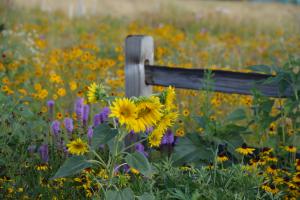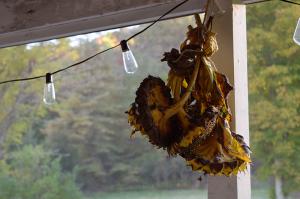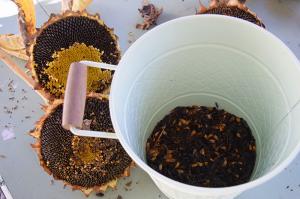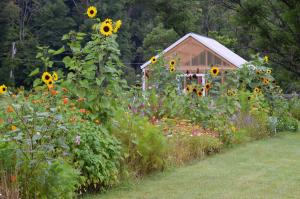When and How to Harvest Sunflower Seeds: Tips from American Meadows Experts

A field of sunflowers lines a rustic fencepost, showcasing the bold color and classic charm of one of the world’s most recognizable flowers. Their vibrant presence adds warmth and visual impact to any landscape.

Dried sunflower heads in varying sizes showcase the diversity of seed production across popular sunflower varieties. Gardeners can harvest thousands of seeds from mature blooms for planting, roasting, or bird feeding.

Sunflower seed heads bundled with twine hang to dry on a shaded porch—capturing the quiet magic of harvest and the joy of bringing the sunflower’s vibrant journey full circle.
Learn when and how to harvest sunflower seeds for planting, roasting, or feeding birds — expert tips from the gardening specialists at American Meadows
The experts at American Meadows say that timing and technique are critical for a successful sunflower seed harvest. Whether gardeners want to plant sunflower seeds next season, roast sunflower seeds for a healthy snack, or feed sunflower seeds to birds through the winter, knowing when and how to harvest sunflower seeds makes all the difference.
CHOOSING SUNFLOWER VARIETIES FOR THE BEST SEED HARVEST
Gardeners who want a bountiful sunflower seed harvest should pay close attention to sunflower varieties. The experts at American Meadows highlight sunflower traits that maximize sunflower seed yield, flavor, and storage potential.
Key traits include:
(1) Large sunflower seed heads that can produce thousands of seeds for planting, roasting, or bird feeding.
(2) Striped or grey-striped hulls, often indicating confection sunflower varieties with tender, flavorful kernels.
(3) Proven performance — drought-tolerant, disease-resistant, and strong germination and storage potential for North American gardens.
American Meadows recommends favorites such as Mammoth Grey Stripe, Autumn Beauty, Earthwalker, Henry Wilde, Moonshine, Lemon Queen, Domino and Red Sun.
SIGNS YOUR SUNFLOWER SEEDS ARE READY TO HARVEST
Sunflowers provide clear signals when their seeds are ready to harvest. The sunflower head begins to droop, the back turns crisp and brown, petals fall, and sunflower seeds appear plump and loose.
In general, sunflower seeds are ready when the flower head starts to droop and the backside dries to a crisp brown, say the experts at American Meadows. Harvesting sunflower seeds too early — while the back is still green — can result in immature sunflower seeds that won’t store, sprout, or taste good.
STEP-BY-STEP GUIDE TO HARVESTING AND DRYING SUNFLOWER SEEDS
1. Cut the sunflower head: Use sharp scissors or pruners about one foot below the bloom once the sunflower is fully mature. Cover with a breathable bag if birds are nibbling on sunflower seeds before harvest.
2. Hang to dry: Suspend sunflower heads upside down in a warm, dry area for 5–7 days. This ensures sunflower seeds fully ripen and makes them easier to remove.
3. Remove the sunflower seeds: Rub the sunflower head over a bucket. Expect some chaff; sift it out later.
4. Dry sunflower seeds for storage: For planting: Rinse sunflower seeds, spread in a single layer on newspaper or a towel, and air-dry completely. Store in an airtight container labeled with sunflower variety and date. For roasting or bird feeding: Follow the same drying process or proceed to soaking and baking.
SAVING SUNFLOWER SEEDS FOR NEXT YEAR
Seed saving is one of the most rewarding parts of gardening, explain the American Meadows experts.
Only save sunflower seeds from fully mature, dry sunflower heads for best results. Store in an airtight container labeled with sunflower variety and date.
Frequently asked questions:
1. Can you save sunflower seeds from cut flowers? Only if fully mature.
2. Will cut sunflowers regrow? No — the stalk won’t produce more flowers or sunflower seeds.
3. Do sunflower seeds need soaking before planting? No — properly dried sunflower seeds are ready once soil warms in spring.
PREPARING SUNFLOWER SEEDS FOR EATING
Sunflower seeds are versatile for both the garden and the kitchen, say the experts. Gardeners can eat sunflower seeds raw, but drying and roasting sunflower seeds enhances flavor and shelf life.
Roasted sunflower seed recipe:
1. Soak sunflower seeds overnight in salted water (or simmer 1–1.5 hours).
2. Drain and dry sunflower seeds thoroughly.
3. Bake at 325°F for 25–30 minutes, stirring often until golden and fragrant.
4. Enjoy sunflower seeds plain, spiced, or oiled.
Quick expert tips:
1. Can you eat raw sunflower seeds? Yes, but large quantities may cause digestive discomfort.
2. Are all sunflower seeds edible? Most common sunflower varieties are, but ornamental types may produce smaller, less flavorful sunflower seeds.
EXPERT PERSPECTIVE ON SUNFLOWER SEED HARVESTING
At American Meadows, we believe gardening should be both beautiful and practical. Harvesting sunflower seeds lets gardeners feed wildlife, grow more sunflowers next season, and enjoy homegrown sunflower seed snacks — all while connecting with the rhythm of the seasons.
“Harvesting sunflower seeds is more than practical—it’s a way to nourish birds, save for next season, and enjoy a timeless snack from your own garden,” shares Tabar Gifford, Master Gardener, Partnership Cultivator, and sunflower enthusiast at American Meadows.
Learn more and get the full step-by-step guide for harvesting sunflower seeds: https://www.americanmeadows.com/content/wildflowers/how-to/harvest-sunflower-seeds
See all American Meadows sunflower seeds: https://www.americanmeadows.com/category/wildflower-seeds/sunflower-seeds
Visit the Wildflower Learning Center: https://www.americanmeadows.com/content/wildflowers
ABOUT AMERICAN MEADOWS
American Meadows is Doing Good Through Gardening. Their innovative wildflower seed mixes, pre-planned perennial gardens, and lawn alternatives are a go-to for online gardeners. With over 40 years of experience and 650,000 happy customers, American Meadows is the authority in meadowscaping. Visit https://www.americanmeadows.com for more.
Tabar Gifford
American Meadows Inc
ltabar@americanmeadows.com
Visit us on social media:
Instagram
Facebook
YouTube
TikTok
LinkedIn
Bluesky
About American Meadows: How Meadowscaping Makes It Better with Pollinator-Friendly Plants & Sustainable Gardening
Legal Disclaimer:
EIN Presswire provides this news content "as is" without warranty of any kind. We do not accept any responsibility or liability for the accuracy, content, images, videos, licenses, completeness, legality, or reliability of the information contained in this article. If you have any complaints or copyright issues related to this article, kindly contact the author above.


